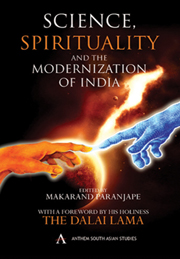Book contents
- Frontmatter
- Contents
- Notes on Contributors
- Foreword
- Editor's Preface
- I Science and Spirituality: East and West
- II Coming to Terms with Science: Some Change Agents
- III Building Bridges: Evolution, Consciousness and Healing
- CHAPTER 8 The Concept of the Yuga: Modern Scientific Approaches to Bridge Spiritual and Philosophical Concepts
- CHAPTER 9 Sri Aurobindo's Concept of Evolution of Consciousness: Exploration through the Paradigm of Health and Disease
- CHAPTER 10 The Blending of Science and Spirituality in the Ayurvedic Tradition of Healing
- CHAPTER 11 Micro-sensing by Indian Mystics
- CHAPTER 12 The Big Picture for the Science of Consciousness
- IV Science and Spirituality: Culture, Society and Gender
CHAPTER 9 - Sri Aurobindo's Concept of Evolution of Consciousness: Exploration through the Paradigm of Health and Disease
from III - Building Bridges: Evolution, Consciousness and Healing
Published online by Cambridge University Press: 05 March 2012
- Frontmatter
- Contents
- Notes on Contributors
- Foreword
- Editor's Preface
- I Science and Spirituality: East and West
- II Coming to Terms with Science: Some Change Agents
- III Building Bridges: Evolution, Consciousness and Healing
- CHAPTER 8 The Concept of the Yuga: Modern Scientific Approaches to Bridge Spiritual and Philosophical Concepts
- CHAPTER 9 Sri Aurobindo's Concept of Evolution of Consciousness: Exploration through the Paradigm of Health and Disease
- CHAPTER 10 The Blending of Science and Spirituality in the Ayurvedic Tradition of Healing
- CHAPTER 11 Micro-sensing by Indian Mystics
- CHAPTER 12 The Big Picture for the Science of Consciousness
- IV Science and Spirituality: Culture, Society and Gender
Summary
This paper examines how Sri Aurobindo extended the concept of evolution as enunciated by Charles Darwin to consciousness and being (personality).
The genius of Charles Darwin pervaded the scientific West in the 1890s. Europe was gripped by the theory of evolution during the formative years of Sri Aurobindo's personality. When he returned to India in 1892 to take up his assignment at Vadodara (then Baroda) under Maharaja Sayaji Rao, the idealist Arvind Ghosh was already on the path to becoming Sri Aurobindo. He was to delve in the modern scientific theories of his time and study Indian philosophical concepts in depth. This was not to search for a synthesis. That would have been an elementary exercise for average minds. The sages and seers evolve their own visions of Reality that transcend the knowledge of their age by a quantum jump. Through the intuitive insight that penetrated the Upanishadic enunciation of Ultimate Reality, he saw that evolution also evolves (Aurobindo, 1921a, pp.1–8). He elaborated on this vision on both individual and universal scales.
This paper limits its scope to the evolution of consciousness of an individual in the unfolding of his/her personality and how it correlates with the expression of health and disease. Sri Aurobindo's philosophical postulates are then juxtaposed with modern science in terms of New Biology and advances in medicine in order to evaluate and establish that he indeed foresaw.
- Type
- Chapter
- Information
- Science, Spirituality and the Modernisation of India , pp. 162 - 168Publisher: Anthem PressPrint publication year: 2009

